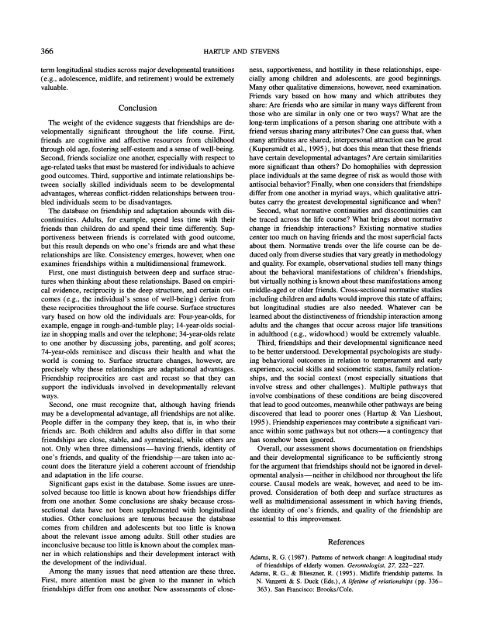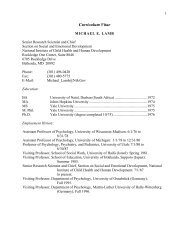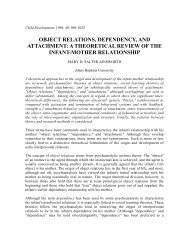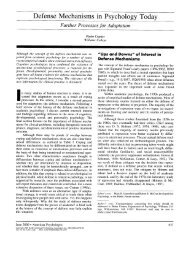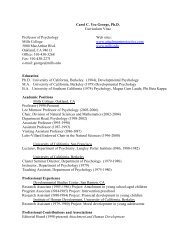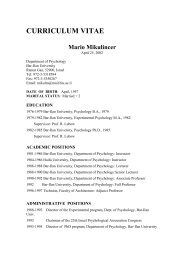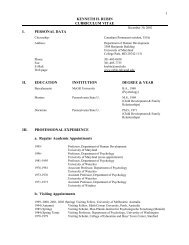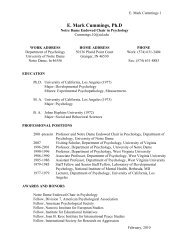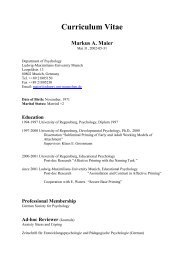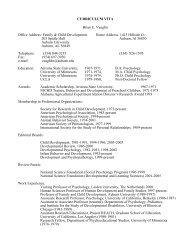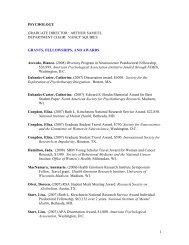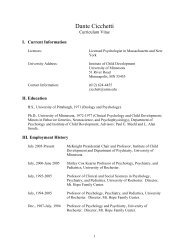Friendships and Adaptation in the Life Course - Psychology ...
Friendships and Adaptation in the Life Course - Psychology ...
Friendships and Adaptation in the Life Course - Psychology ...
You also want an ePaper? Increase the reach of your titles
YUMPU automatically turns print PDFs into web optimized ePapers that Google loves.
366 HARTUP AND STEVENS<br />
term longitud<strong>in</strong>al studies across major developmental transitions<br />
(e.g., adolescence, midlife, <strong>and</strong> retirement) would be extremely<br />
valuable.<br />
Conclusion<br />
The weight of <strong>the</strong> evidence suggests that friendships are de-<br />
velopmentally significant throughout <strong>the</strong> life course. First,<br />
friends are cognitive <strong>and</strong> affective resources from childhood<br />
through old age, foster<strong>in</strong>g self-esteem <strong>and</strong> a sense of well-be<strong>in</strong>g.<br />
Second, friends socialize one ano<strong>the</strong>r, especially with respect to<br />
age-related tasks that must be mastered for <strong>in</strong>dividuals to achieve<br />
good outcomes. Third, supportive <strong>and</strong> <strong>in</strong>timate relationships be-<br />
tween socially skilled <strong>in</strong>dividuals seem to be developmental<br />
advantages, whereas conflict-ridden relationships between trou-<br />
bled <strong>in</strong>dividuals seem to be disadvantages.<br />
The database on friendship <strong>and</strong> adaptation abounds with dis-<br />
cont<strong>in</strong>uities. Adults, for example, spend less time with <strong>the</strong>ir<br />
friends than children do <strong>and</strong> spend <strong>the</strong>ir time differently. Sup-<br />
portiveness between friends is correlated with good outcome,<br />
but this result depends on who one's friends are <strong>and</strong> what <strong>the</strong>se<br />
relationships are like. Consistency emerges, however, when one<br />
exam<strong>in</strong>es friendships with<strong>in</strong> a multidimensional framework.<br />
First, one must dist<strong>in</strong>guish between deep <strong>and</strong> surface struc-<br />
tures when th<strong>in</strong>k<strong>in</strong>g about <strong>the</strong>se relationships. Based on empiri-<br />
cal evidence, reciprocity is <strong>the</strong> deep structure, <strong>and</strong> certa<strong>in</strong> out-<br />
comes (e.g., <strong>the</strong> <strong>in</strong>dividual's sense of well-be<strong>in</strong>g) derive from<br />
<strong>the</strong>se reciprocities throughout <strong>the</strong> life course. Surface structures<br />
vary based on how old <strong>the</strong> <strong>in</strong>dividuals are: Four-year-olds, for<br />
example, engage <strong>in</strong> rough-<strong>and</strong>-tumble play; 14-year-olds social-<br />
ize <strong>in</strong> shopp<strong>in</strong>g malls <strong>and</strong> over <strong>the</strong> telephone; 34-year-olds relate<br />
to one ano<strong>the</strong>r by discuss<strong>in</strong>g jobs, parent<strong>in</strong>g, <strong>and</strong> golf scores;<br />
74-year-olds rem<strong>in</strong>isce <strong>and</strong> discuss <strong>the</strong>ir health <strong>and</strong> what <strong>the</strong><br />
world is com<strong>in</strong>g to. Surface structure changes, however, are<br />
precisely why <strong>the</strong>se relationships are adaptational advantages.<br />
Friendship reciprocities are cast <strong>and</strong> recast so that <strong>the</strong>y can<br />
support <strong>the</strong> <strong>in</strong>dividuals <strong>in</strong>volved <strong>in</strong> developmentally relevant<br />
ways.<br />
Second, one must recognize that, although hav<strong>in</strong>g friends<br />
may be a developmental advantage, all friendships are not alike.<br />
People differ <strong>in</strong> <strong>the</strong> company <strong>the</strong>y keep, that is, <strong>in</strong> who <strong>the</strong>ir<br />
friends are. Both children <strong>and</strong> adults also differ <strong>in</strong> that some<br />
friendships are close, stable, <strong>and</strong> symmetrical, while o<strong>the</strong>rs are<br />
not. Only when three dimensions--hav<strong>in</strong>g friends, identity of<br />
one's friends, <strong>and</strong> quality of <strong>the</strong> friendship--are taken <strong>in</strong>to ac-<br />
count does <strong>the</strong> literature yield a coherent account of friendship<br />
<strong>and</strong> adaptation <strong>in</strong> <strong>the</strong> life course.<br />
Significant gaps exist <strong>in</strong> <strong>the</strong> database. Some issues are unre-<br />
solved because too little is known about how friendships differ<br />
from one ano<strong>the</strong>r. Some conclusions are shaky because cross-<br />
sectional data have not been supplemented with longitud<strong>in</strong>al<br />
studies. O<strong>the</strong>r conclusions are tenuous because <strong>the</strong> database<br />
comes from children <strong>and</strong> adolescents but too little is known<br />
about <strong>the</strong> relevant issue among adults. Still o<strong>the</strong>r studies are<br />
<strong>in</strong>conclusive because too little is known about <strong>the</strong> complex man-<br />
ner <strong>in</strong> which relationships <strong>and</strong> <strong>the</strong>ir development <strong>in</strong>teract with<br />
<strong>the</strong> development of <strong>the</strong> <strong>in</strong>dividual.<br />
Among <strong>the</strong> many issues that need attention are <strong>the</strong>se three.<br />
First, more attention must be given to <strong>the</strong> manner <strong>in</strong> which<br />
friendships differ from one ano<strong>the</strong>r. New assessments of close-<br />
ness, supportiveness, <strong>and</strong> hostility <strong>in</strong> <strong>the</strong>se relationships, espe-<br />
cially among children <strong>and</strong> adolescents, are good beg<strong>in</strong>n<strong>in</strong>gs.<br />
Many o<strong>the</strong>r qualitative dimensions, however, need exam<strong>in</strong>ation.<br />
Friends vary based on how many <strong>and</strong> which attributes <strong>the</strong>y<br />
share: Are friends who are similar <strong>in</strong> many ways different from<br />
those who are similar <strong>in</strong> only one or two ways? What are <strong>the</strong><br />
long-term implications of a person shar<strong>in</strong>g one attribute with a<br />
friend versus shar<strong>in</strong>g many attributes? One can guess that, when<br />
many attributes are shared, <strong>in</strong>terpersonal attraction can be great<br />
(Kupersmidt et al., 1995), but does this mean that <strong>the</strong>se friends<br />
have certa<strong>in</strong> developmental advantages? Are certa<strong>in</strong> similarities<br />
more significant than o<strong>the</strong>rs? Do homophilies with depression<br />
place <strong>in</strong>dividuals at <strong>the</strong> same degree of risk as would those with<br />
antisocial behavior? F<strong>in</strong>ally, when one considers that friendships<br />
differ from one ano<strong>the</strong>r <strong>in</strong> myriad ways, which qualitative attri-<br />
butes carry <strong>the</strong> greatest developmental significance <strong>and</strong> when?<br />
Second, what normative cont<strong>in</strong>uities <strong>and</strong> discont<strong>in</strong>uities can<br />
be traced across <strong>the</strong> life course? What br<strong>in</strong>gs about normative<br />
change <strong>in</strong> friendship <strong>in</strong>teractions? Exist<strong>in</strong>g normative studies<br />
center too much on hav<strong>in</strong>g friends <strong>and</strong> <strong>the</strong> most superficial facts<br />
about <strong>the</strong>m. Normative trends over <strong>the</strong> life course can be de-<br />
duced only from diverse studies that vary greatly <strong>in</strong> methodology<br />
<strong>and</strong> quality. For example, observational studies tell many th<strong>in</strong>gs<br />
about <strong>the</strong> behavioral manifestations of children's friendships,<br />
but virtually noth<strong>in</strong>g is known about <strong>the</strong>se manifestations among<br />
middle-aged or older friends. Cross-sectional normative studies<br />
<strong>in</strong>clud<strong>in</strong>g children <strong>and</strong> adults would improve this state of affairs;<br />
but longitud<strong>in</strong>al studies are also needed. Whatever can be<br />
learned about <strong>the</strong> dist<strong>in</strong>ctiveness of friendship <strong>in</strong>teraction among<br />
adults <strong>and</strong> <strong>the</strong> changes that occur across major life transitions<br />
<strong>in</strong> adulthood (e.g., widowhood) would be extremely valuable.<br />
Third, friendships <strong>and</strong> <strong>the</strong>ir developmental significance need<br />
to be better understood. Developmental psychologists are study-<br />
<strong>in</strong>g behavioral outcomes <strong>in</strong> relation to temperament <strong>and</strong> early<br />
experience, social skills <strong>and</strong> sociometric status, family relation-<br />
ships, <strong>and</strong> <strong>the</strong> social context (most especially situations that<br />
<strong>in</strong>volve stress <strong>and</strong> o<strong>the</strong>r challenges). Multiple pathways that<br />
<strong>in</strong>volve comb<strong>in</strong>ations of <strong>the</strong>se conditions are be<strong>in</strong>g discovered<br />
that lead to good outcomes, meanwhile o<strong>the</strong>r pathways are be<strong>in</strong>g<br />
discovered that lead to poorer ones (Hartup & Van Lieshout,<br />
1995). Friendship experiences may contribute a significant vari-<br />
ance with<strong>in</strong> some pathways but not o<strong>the</strong>rs--a cont<strong>in</strong>gency that<br />
has somehow been ignored.<br />
Overall, our assessment shows documentation on friendships<br />
<strong>and</strong> <strong>the</strong>ir developmental significance to be sufficiently strong<br />
for <strong>the</strong> argument that friendships should not be ignored <strong>in</strong> devel-<br />
opmental analysis--nei<strong>the</strong>r <strong>in</strong> childhood nor throughout <strong>the</strong> life<br />
course. Causal models are weak, however, <strong>and</strong> need to be im-<br />
proved. Consideration of both deep <strong>and</strong> surface structures as<br />
well as multidimensional assessment <strong>in</strong> which hav<strong>in</strong>g friends,<br />
<strong>the</strong> identity of one's friends, <strong>and</strong> quality of <strong>the</strong> friendship are<br />
essential to this improvement.<br />
References<br />
Adams, R. G. (1987). Patterns of network change: A longitud<strong>in</strong>al study<br />
of friendships of elderly women. Gerontologist, 27, 222-227.<br />
Adams, R. G., & Blieszner, R. (1995). Midlife friendship patterns. In<br />
N. Vanzetti & S. Duck (Eds.), A lifetime of relationships (pp. 336-<br />
363). San Francisco: Brooks/Cole.


